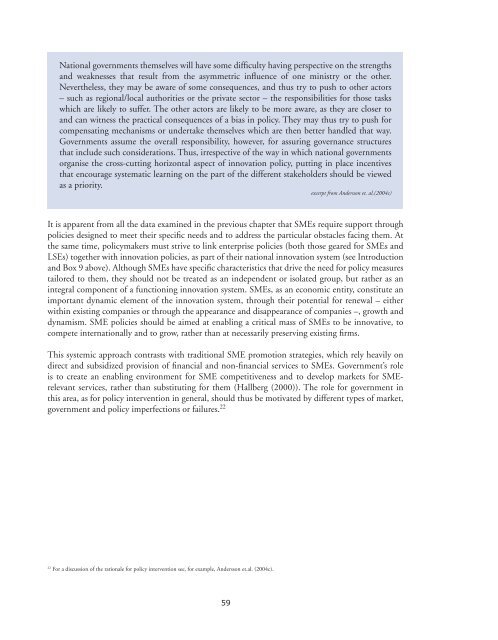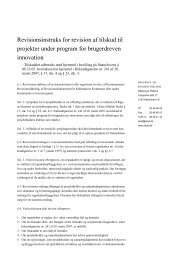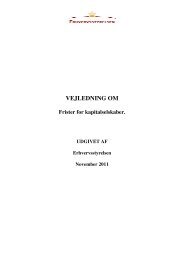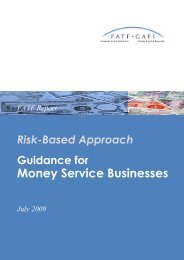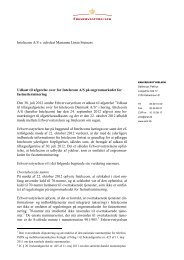Competing in the Single Market - SMEs and ... - Erhvervsstyrelsen
Competing in the Single Market - SMEs and ... - Erhvervsstyrelsen
Competing in the Single Market - SMEs and ... - Erhvervsstyrelsen
Create successful ePaper yourself
Turn your PDF publications into a flip-book with our unique Google optimized e-Paper software.
National governments <strong>the</strong>mselves will have some difficulty hav<strong>in</strong>g perspective on <strong>the</strong> strengths<strong>and</strong> weaknesses that result from <strong>the</strong> asymmetric <strong>in</strong>fluence of one m<strong>in</strong>istry or <strong>the</strong> o<strong>the</strong>r.Never<strong>the</strong>less, <strong>the</strong>y may be aware of some consequences, <strong>and</strong> thus try to push to o<strong>the</strong>r actors– such as regional/local authorities or <strong>the</strong> private sector – <strong>the</strong> responsibilities for those taskswhich are likely to suffer. The o<strong>the</strong>r actors are likely to be more aware, as <strong>the</strong>y are closer to<strong>and</strong> can witness <strong>the</strong> practical consequences of a bias <strong>in</strong> policy. They may thus try to push forcompensat<strong>in</strong>g mechanisms or undertake <strong>the</strong>mselves which are <strong>the</strong>n better h<strong>and</strong>led that way.Governments assume <strong>the</strong> overall responsibility, however, for assur<strong>in</strong>g governance structuresthat <strong>in</strong>clude such considerations. Thus, irrespective of <strong>the</strong> way <strong>in</strong> which national governmentsorganise <strong>the</strong> cross-cutt<strong>in</strong>g horizontal aspect of <strong>in</strong>novation policy, putt<strong>in</strong>g <strong>in</strong> place <strong>in</strong>centivesthat encourage systematic learn<strong>in</strong>g on <strong>the</strong> part of <strong>the</strong> different stakeholders should be viewedas a priority.excerpt from Andersson et. al.(2004c)It is apparent from all <strong>the</strong> data exam<strong>in</strong>ed <strong>in</strong> <strong>the</strong> previous chapter that <strong>SMEs</strong> require support throughpolicies designed to meet <strong>the</strong>ir specific needs <strong>and</strong> to address <strong>the</strong> particular obstacles fac<strong>in</strong>g <strong>the</strong>m. At<strong>the</strong> same time, policymakers must strive to l<strong>in</strong>k enterprise policies (both those geared for <strong>SMEs</strong> <strong>and</strong>LSEs) toge<strong>the</strong>r with <strong>in</strong>novation policies, as part of <strong>the</strong>ir national <strong>in</strong>novation system (see Introduction<strong>and</strong> Box 9 above). Although <strong>SMEs</strong> have specific characteristics that drive <strong>the</strong> need for policy measurestailored to <strong>the</strong>m, <strong>the</strong>y should not be treated as an <strong>in</strong>dependent or isolated group, but ra<strong>the</strong>r as an<strong>in</strong>tegral component of a function<strong>in</strong>g <strong>in</strong>novation system. <strong>SMEs</strong>, as an economic entity, constitute animportant dynamic element of <strong>the</strong> <strong>in</strong>novation system, through <strong>the</strong>ir potential for renewal – ei<strong>the</strong>rwith<strong>in</strong> exist<strong>in</strong>g companies or through <strong>the</strong> appearance <strong>and</strong> disappearance of companies –, growth <strong>and</strong>dynamism. SME policies should be aimed at enabl<strong>in</strong>g a critical mass of <strong>SMEs</strong> to be <strong>in</strong>novative, tocompete <strong>in</strong>ternationally <strong>and</strong> to grow, ra<strong>the</strong>r than at necessarily preserv<strong>in</strong>g exist<strong>in</strong>g firms.This systemic approach contrasts with traditional SME promotion strategies, which rely heavily ondirect <strong>and</strong> subsidized provision of f<strong>in</strong>ancial <strong>and</strong> non-f<strong>in</strong>ancial services to <strong>SMEs</strong>. Government’s roleis to create an enabl<strong>in</strong>g environment for SME competitiveness <strong>and</strong> to develop markets for SMErelevantservices, ra<strong>the</strong>r than substitut<strong>in</strong>g for <strong>the</strong>m (Hallberg (2000)). The role for government <strong>in</strong>this area, as for policy <strong>in</strong>tervention <strong>in</strong> general, should thus be motivated by different types of market,government <strong>and</strong> policy imperfections or failures. 2222For a discussion of <strong>the</strong> rationale for policy <strong>in</strong>tervention see, for example, Andersson et.al. (2004c).59


